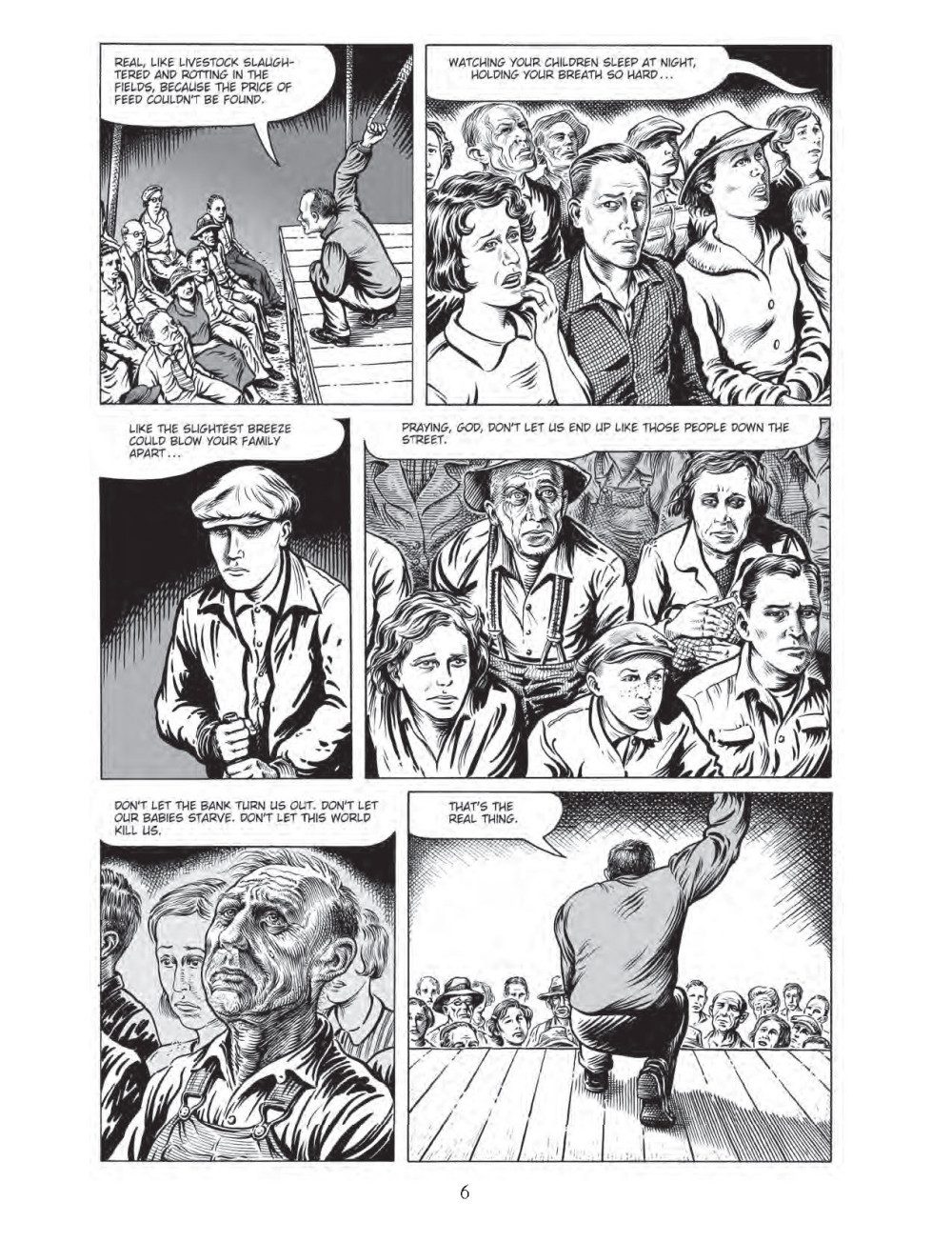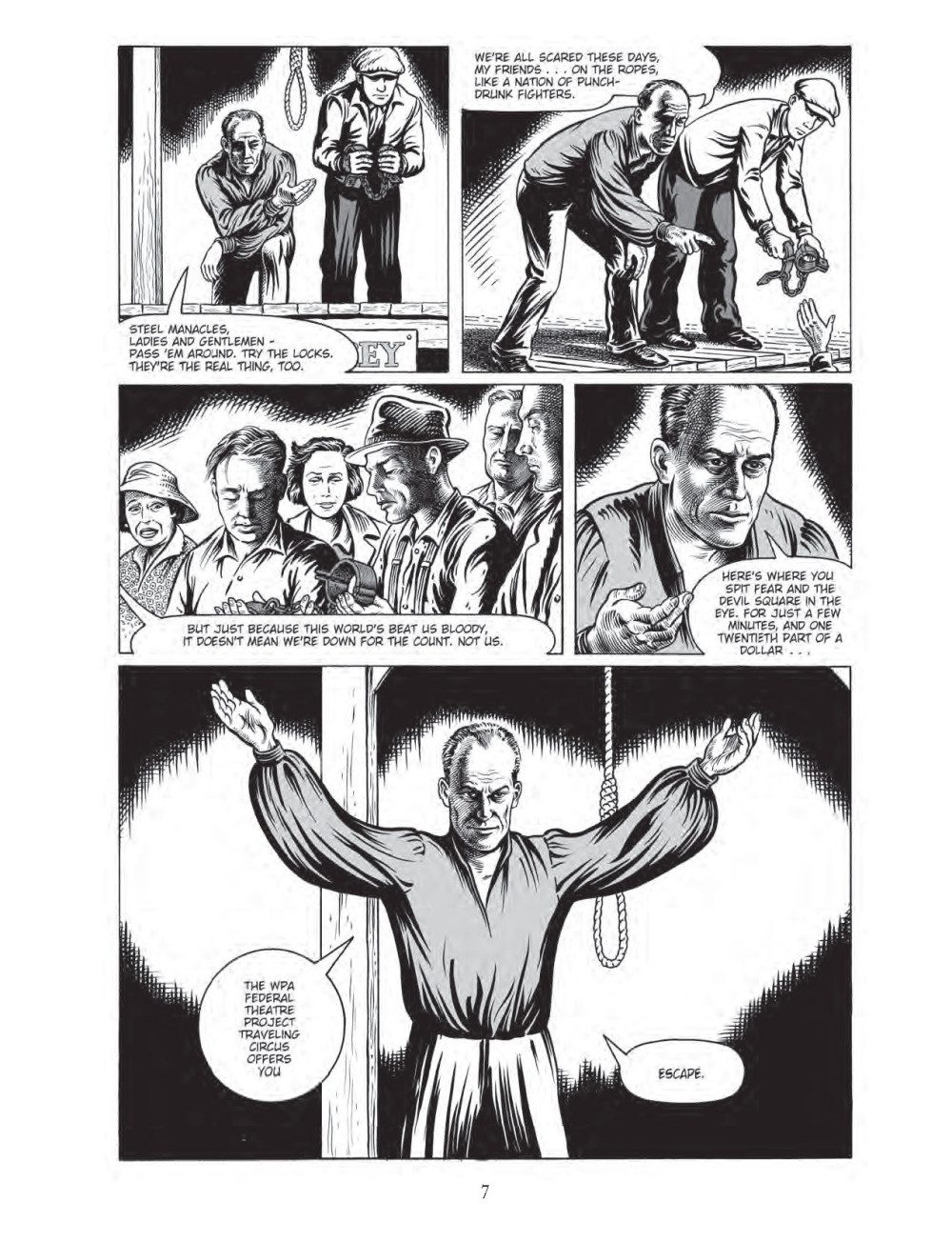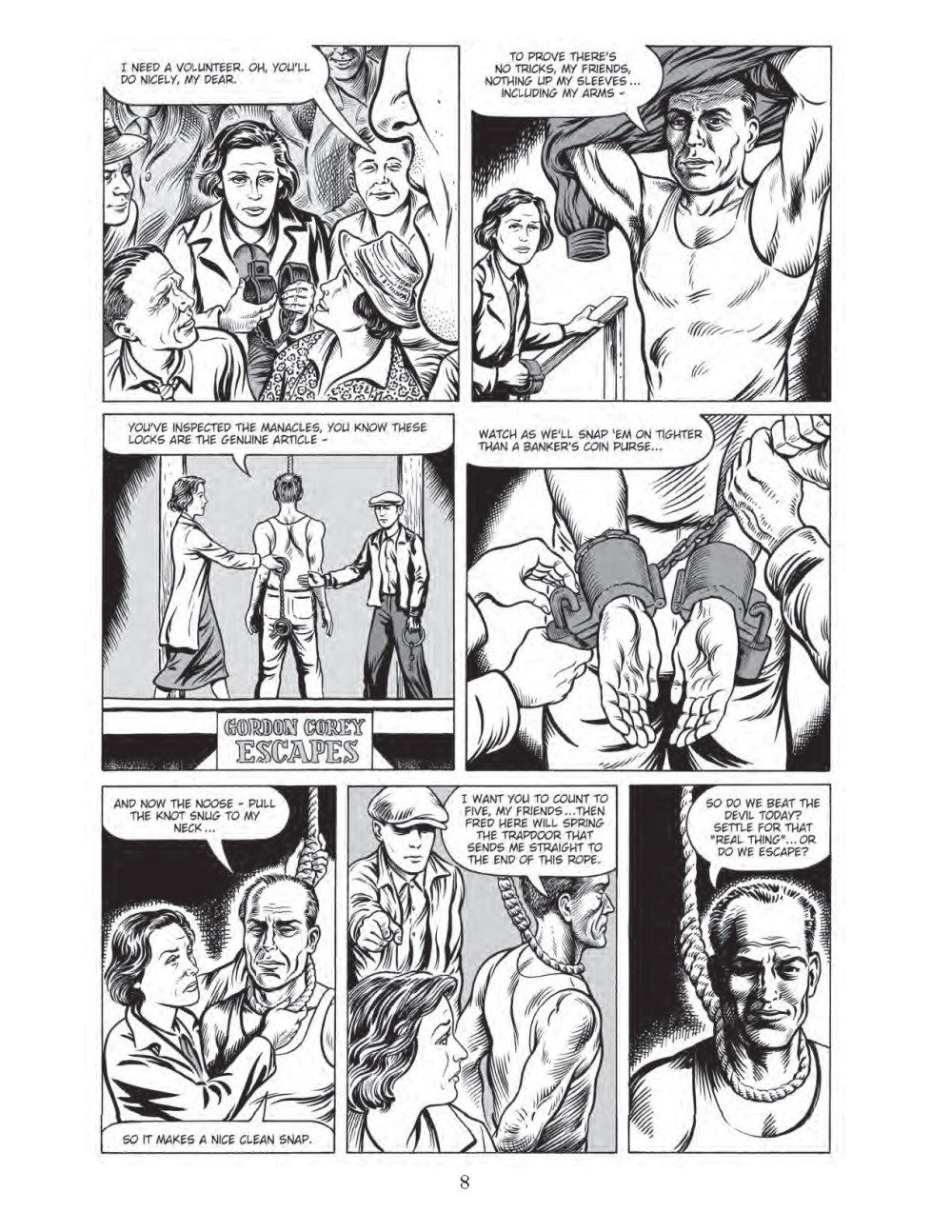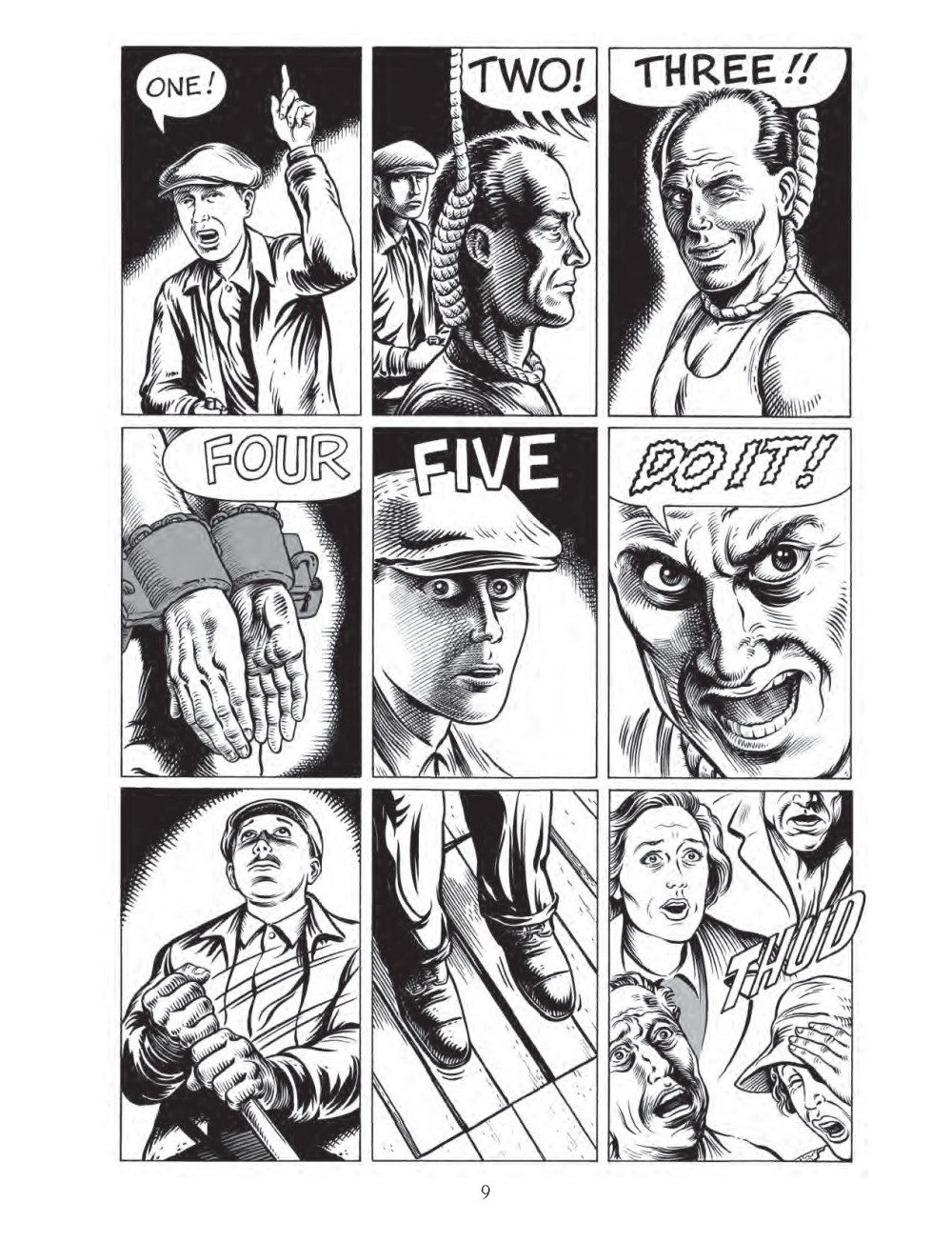I emailed James Vance having just finished On the Ropes, his recent collaboration with the cartoonist Dan Burr, and after several days spent in the world of his book, I tried to not take the ease of communication for granted. On the Ropes continues the story Vance and Burr began in Kings in Disguise, a Great Depression narrative that won Eisner- and Harvey Awards in the late 1980s. Ropes follows the trials of Fred Bloch, the young lead of Kings in Disguise, now prematurely old at seventeen. Fred travels the Midwest with a WPA Federal Theater Project traveling circus while acting as a liaison for union workers in the region, relaying messages and avoiding the wrath of “labor controllers.”
Vance stayed active in the comics industry following the success of Kings in Disguise, but On the Ropes marks his first return to the Great Depression. The book is not a deliberate comment on the more recent global recession, as Vance is quick to note. Even so, readers are likely to recognize its depictions of dashed hopes for progress or abuses of power. Vance and Burr’s Fred Bloch is, if not wholly a victim, than not a hero, either. But he’s likewise recognizable as a person straining to live according to his heart and his principles in a time when much lies beyond his control.
Vance and I discussed the Depression, creeping pessimism, and the challenges of exploring these subjects within the comics form.
***
The Rumpus: Describe your collaboration with Dan Burr. How detailed is a script of yours when he first sees it?
James Vance: When I first started writing comics with Kings in Disguise, Alan Moore was becoming famous for his phone book-thick comics scripts, and I’m afraid that had an influence on me. I used to pile on the detail, which was probably a way of hedging my bets while I was working out my own way of doing things. I’ve cut it back over the years, but some of the descriptions can still be still pretty dense. So the answer is somewhere between fairly detailed and maybe too detailed. Fortunately, people are seeing the final pages and not my raw script. 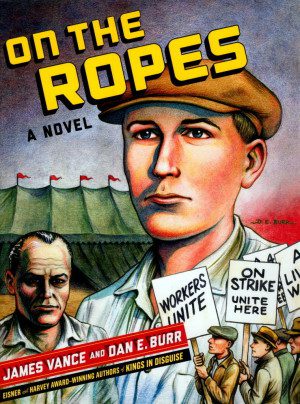
I suppose we have a fairly old-fashioned way of doing things: I write a full script, and Dan draws it. But it isn’t the master-slave relationship that it sounds like. We’ve worked together so often over the years that I have a pretty good feel for what he’s going to be able to do with a scene, and of course, we’ve already batted his preliminary character sketches back and forth—so even though the descriptions and dialogue are written by me, while it’s being written it’s all influenced by a good working notion of the way Dan’s going to interpret it. And of course, there’s always the understanding between us that unless we’re talking about a vital piece of action that a beat depends on, my descriptions are just suggestions. If Dan has a better idea, I want him to go with what he thinks is best. We’re telling this story together.
When we started working together back in the ’80s, we were being serialized in comic book format, because that’s largely the way everything was done then. So I’d type up a script, send it to our editor, and he’d pass it on to Dan. If I wanted to send him visual reference, I’d make copies from books or newspapers on microfilm and snail-mail those to Dan’s home. With On the Ropes, of course, we could do the whole thing via e-mail and I could send him links to reference online, or photos I’d taken of something that wasn’t immediately available. So the whole process was very streamlined compared to those old, prehistoric days, and it was possible to discuss the little problem areas that came up and have them resolved the same day.
And a huge advantage this time was not having to serialize. The length of those installments of Kings was set in stone, and the story was being published before we’d completed it. With Ropes coming out as a single unit, we had the luxury of not publishing until we decided it was ready. The published book was as long as we needed it to be, not as long as someone else dictated to us—so I could send Dan a couple of pages to insert after page 111 or whatever, or say, “How about we expand the opening this way?” It gave us the freedom to give the story more depth and to have greater control over the pace and texture.
The important thing about collaborating with Dan is the complete confidence I have in him. I tell people that he can read my mind, because he has a practically infallible grasp of the emotional nuance of a scene. The style he uses when we work together isn’t full of flashy effects, but he’s such a master of the life-size human moments that I think Ropes is a bravura performance on his part. I made it a point to include silent sequences in this story just because I wanted those pages to rely completely on his art. There are wordless passages in the book that take my breath away because the changes he’s putting the characters through are so human and so real.
Rumpus: I was also curious if, for the story you wanted to tell, the comics medium presented specific advantages.
Vance: I’d forgotten how challenging comics can be until I started working on Ropes. Yes, you’re restricted by the boundaries of the page, but we all work within technical limitations of some kind. There’s a certain pressure you put on yourself to use the comics page to full advantage that can focus your mind to a pinpoint, and when the juices are flowing, that’s incredibly exciting. When you’ve managed to fit a complex set of actions or a complicated emotional passage into a single page there’s the sense of satisfaction that I suspect a sculptor gets from chipping away at a piece of stone and ending up with a fully-realized work of art.
I’m not sure I can name a kind of story that wouldn’t work in comics form. It’s words and images, and we’ve been telling all kinds of stories with that combination since theatre was invented thousands of years ago. I’ve been asked if I’d consider doing Ropes as a straight novel—which is flattering, I suppose—but I can’t imagine why I’d want to limit myself that way. There’s a certain immediacy we gain from that specific image of Fred being struck by a revelation, of those union workers appearing from the shadows in an alley, of a lonely woman wondering for just a moment if she should make a pass at this young man in her hotel room… And, of course, in a piece like this that’s set in a specific period, and which flashes back to several other specific times and places, it places the reader so firmly and viscerally in the setting that we can concentrate on the characters and the story that they’re living, without piling on verbiage devoted to endless world-building.
Rumpus: I know that you wrote a version of On the Ropes—or at least a play that shares its title and the character of Fred Bloch—in the late 1970s. Had the On the Ropes graphic novel been in development for many years, or did more recent events spur you and Dan to collaborate again?
Vance: Right, the stage version of Ropes was written several years before the stage version of Kings—the Kings play, in fact, came about just because I found myself curious about how our protagonist Fred had gotten started on the path that led him to his situation in On the Ropes. (I hope that’s convoluted enough for you.) So when we were transforming Kings into a graphic novel, I already knew where Fred would go next and I had the possibility of adapting Ropes as a follow-up in the back of my mind. It was something I kicked around on and off for years after that, but I knew it was going to be a huge undertaking in terms of research and rethinking, and life was just too chaotic at that time to make the commitment.
The truth is, we started on the book a couple of years before the global economic collapse, so we weren’t piggybacking on everybody’s misery. There was a point when Dan called me and said, “We started out doing a period piece and now we’re current affairs,” and we had a good laugh over it, or at least as much of a laugh as you can manage while people are struggling to make ends meet. But knowing that the world had come full circle to our Depression story didn’t change the way we worked on it, or encourage us to change our thrust. I want people to be able to pick up this book in the future no matter what’s going on in the world, and appreciate it on its own merits, not for any perceived winks at the headlines.
Rumpus: On the Ropes even addresses the problems of art that’s too polemical or too baldly allegorical—at one point, a journalist takes issue with all the leftist rhetoric in a manuscript Fred asks her to read. Can you recall any works of art that did help shape your politics?
Vance: Understand, my own politics aren’t necessarily interchangeable with what any of my characters believe. You could take each of the characters in On the Ropes, and I’d probably be in sympathy with a different one on any given day, depending on what’s going on in the world. My personal beliefs were shaped more by experience and by watching the news when I was young: images of angelic-looking college students in Mississippi crying like the world was ending because black people were being allowed on their campus; the slow mounting horror of Vietnam on the evening news every night; sitting with my parents in front of the TV and being appalled at the way the Chicago police were treating the protesters during the ’68 Democratic convention. Being eyed with suspicion because of my age and the way I wore my hair.
In researching Kings in Disguise and On the Ropes, I’ve tended to read historical accounts and oral histories instead of artistic interpretations. It was a deliberate choice to avoid duplicating other writers’ work about the subject or the period. I’ve never read or watched Ironweed, never seen Wild Boys of the Road. I know I did read In Dubious Battle years ago, even before I started on the stage version of Ropes, and I remember it as being a good piece of work that wasn’t too polemical, though I have little working memory of it now. For the original play I did spend some time reading magazine articles from labor-friendly little magazines of the ’30s, like The Anvil, and I thought they were pretty rough-going. Lots of mount-the-barricades rhetoric, very heavy-handed. I was working from that experience when I wrote the scene you mentioned with Barbara trashing Fred’s manuscript. And I’m sure, below the surface, there was something of the older me telling the much younger me to take a step back, to try writing with the head as well as the heart.
Rumpus: In researching the books, did you have any revelations about the Great Depression? How often did you come across a piece of information that suddenly demanded to be a part of your story?
Vance: The play served as a good basic outline for the book version of On the Ropes, so the main historical framework was already in place. But what particularly struck me were some of the grace notes I lucked into. Just to name one, an oral history I ran across talked about a union campaigner being framed by police who planted dynamite in his car, and I repurposed that with a punch line of my own to illustrate the climate of paranoia while the steel strikes were being planned. And there was the realization that the “Battle of the Overpass,” a famous incident when Henry Ford’s goons beat up a couple of UAW organizers, not only took place simultaneously with the beginning of the Republic Steel strike, but also at the same place where Fred witnessed his first act of violence against labor in Kings in Disguise.
In fact, the sheer cascade of events during the short time comprised by the main part of the story was so loaded with incident that I had to be careful not to end up writing 1937’s Greatest Hits. The Hindenburg exploded. The Golden Gate Bridge was opened. Within a few weeks, the pro-labor musical The Cradle Will Rock would break away from the WPA Theater and mark the beginning of Orson Welles’s Mercury Theater. Amelia Earhart would vanish. The more I read, the more I was taken with the pressure people must have been living under at that time, with something new either literally or figuratively blowing up in their faces on almost a daily basis.
Rumpus: The WPA traveling circus seemed too strange a thing to be drawn from anywhere but real life, and sure enough, this was a real phenomenon. Was a WPA circus part of the original Ropes stage production?
Vance: Yes, the setting was the circus from the beginning, and the actor who played Gordon really performed his sideshow escape act every night. The main difference between the real WPA circus and the one in both versions of On the Ropes was one of scale. The real-life circus traveled, but pretty much only between sites in New York and New Jersey. It was a fairly large set-up with elephants and horses and a genuine Big Top. The idea of creating a smaller traveling circus in the Midwest as a pilot program was my invention, a way of getting the action near Chicago. And by limiting its scope to units that could be trucked down the local roads—as opposed to using a circus train—I could tie its route into Fred’s particular mission for the union organizers.
Rumpus: Despite what On the Ropes and Kings in Disguise have in common, readers can find a striking contrast in the books’ respective closing lines. The ending of Kings has an optimistic pitch: “So I took to the road once more—on my own, yet accompanied by multitudes. There was another dream out there, and I knew that somewhere on that road, we would find it.” In On the Ropes, Fred cautions himself not to waste his life and refers to the fight for worker’s rights as “a cause that would break my heart.” Some of this ambivalence is Gordon’s, but we wonder if Fred shares it. Do you believe this sequel is a more pessimistic work than the one that came before it?
Vance: In a way, yes, because it’s deliberately more realistic. In Kings in Disguise, Fred is a child, and his understanding of the world is simplistic, interpreting what he sees in black-and-white terms and cartoonish dreams. At the beginning of Ropes, he’s older but barely more mature, and during that story he starts to grow up and gain a more nuanced view of human nature. In his case, it’s a particularly brutal lesson, but still one that’s awakened him to the shades of gray in human relationships. In On the Ropes, it can seem that no good intention goes unpunished – but there’s also the realization that the most damaged of us can rise above the guilt that weighs us down and commit an act that makes a positive difference in our small part of the world. And, yes, for all the idealism that propels him through the story, if you read between the lines you may see that at a moment which he considers a defining point in his life as an activist, he’s also set the stage for potential ugliness down the road.
Rumpus: I ask about optimism/pessimism in part because I read George Packer’s survey of long-form reporting about the Great Depression and Great Recession, from the April 29th New Yorker, around the time I read On the Ropes. Packer describes Edmund Wilson and others surveying the depressed United States and producing work focused on working-class causalities of the economic downturn. Often, the pieces are calls to arms. Whereas Packer notes that many of the more visible stories about our contemporary crisis document shame, futility, without the earlier expectation of a vast societal change. This is all a way of saying that, inasmuch as Ropes is a stark read, it’s very much of our times, and I wanted to know if you had hoped to emphasize any parallels between the Great Depression and contemporary life.
Vance: The idea wasn’t to make a direct political statement since the current economic collapse hadn’t begun when we started on the book. The parallels I’m most interested in are the ways that human nature never changes, no matter how far back in time you look. I did a lot of work with early 20th century attitudes, the kind of superficial notions and behavior that prompt people who don’t know history very well to think that “people were different back then”—but beneath all that are characters who react in ways that we can all recognize, and will always be able to recognize.
All the same, I can’t blame anyone for being pessimistic when they look around, after all the blood spilled and energy spent to gain ground for working people in the past, and see it all happening again. I wasn’t pointing a finger when I wrote the book, but sometimes the message is there even when you aren’t actively trying to be the messenger.
***
Excerpted from On the Ropes by James Vance and Dan Burr. Copyright © 2013 by Cat Dancer Corporation and Dan E. Burr. With permission of the publisher, W.W. Norton & Company, Inc.


